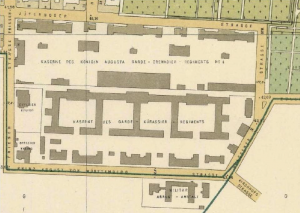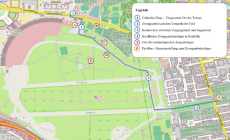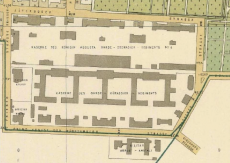Walking Tour of Tempelhof Field: 1. Columbia House – A forgotten site of terror
Deutsch
There is no memorial site located at Columbiadamm to remember the victims of the former prison or of the concentration camp. Instead, only a plain steel sculpture recalls the atrocities committed here and serves as a warning to future generations. Between 1933 and 1945, the Columbia House (Columbia-Haus) existed as a concentration camp – the first to be located within the Berlin city limits.
The sculpture is actually positioned on the “wrong” side of the street. The Columbia House was in fact located on the opposite side of the street, and was originally constructed in 1896 as part of a military barracks complex on Friesenstrasse. In the summer of 1933, after the Nazis took power, the Gestapo (short for Geheime Staatspolizei, Secret State Police) converted the barracks into a prison for political activists and anyone who voiced opposition to the regime. In February 1934, a recorded total of 450 people were imprisoned and tortured by the Protection Squadron Schutzstaffel (SS) at the prison, an outpost of the Gestapo Headquarters. Prisoners who had yet to be interrogated were temporarily placed at the camp until their interrogations had been completed. This meant that prisoners were transported daily between Columbia House and the Gestapo headquarters on Prinz-Albrecht-Strasse.

Next to the barracks (Kaserne)– currently a police station – on the former Prinz-August-von-Württemburg-Strasse, the outline of the former military barracks-turned-concentration-camp can still be seen.
Source: City Map of 1895, Verlag Julius Straube, http://de.wikipedia.org/w/index.php?title=Datei:Lageplan_Columbia-KZ.jpg&filetimestamp=20080725174359
In December of 1934 the SS administrators in charge of the concentration camps officially labeled the prison a concentration camp. In the picture above, taken in 1905, you can see the military compound that was converted into the concentration camp. The majority of prisoners were men and were predominantly political prisoners, communists, socialists and/or intellectuals, which tended to be the case in many of the initial concentration camps.
In the early months of 1935, the Nazi party organized several police raids in order to enforce new, stricter statutes. As a result, several homosexual men were arrested (male homosexuality was an official Nazi crime) and imprisoned at the Columbia House concentration camp. Those arrested for crimes of homosexuality eventually made up half of the inmates at the camp.
In 1936 the Columbia House concentration camp was closed and the prisoners were transported to the Sachsenhausen concentration camp in Oranienburg, north of Berlin. Altogether an estimated 8,000 men were imprisoned at Columbia House, including Ernst Thälman (Head of the Communist Party of Germany from 1925-1933) and Erich Hönecker (General Secretary of the German Democratic Republic from 1971-89). Today, the building belonging to the concentration camp no longer exists; it was demolished in 1938 in order to make room for construction of the new airport building at Tempelhof.
Remember the steel sculpture and how it is positioned on the “wrong” side of the street instead of at the actual historical location of Columbia House? This happened as a result of minimal public interest in the topic of Tempelhof Field’s Nazi past. Berlin’s district representatives and some dedicated citizens have, however, recently begun to advocate for the relocation of the sculpture so that it will stand where Columbia House actually once stood. In addition, they would like to develop an information and memorial center in remembrance of the concentration camp and those who were imprisoned, tortured and killed within its gates. The results of the current debate concerning the steel sculpture and the eventual erection of a memorial center remain to be seen.
On the opposite side of the street we now proceed to the next station on our Walking Tour.
Teresa Veerman
Read on
- Walking Tour Tempelhofer Feld (PDF for printing, in German)
- Kurt Schilde / Johannes Tuchel, Columbia-Haus. Berliner Konzentrationslager 1933-1936, Berlin 1990.







